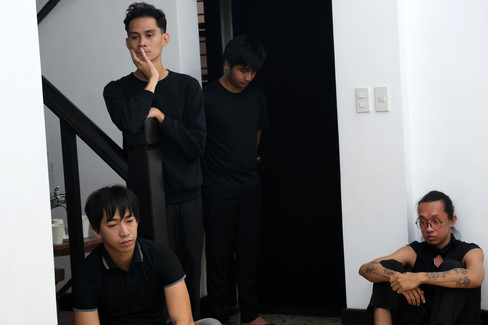What happened in the shame research laboratory?
- langgamperformancetroupe
- Aug 2, 2023
- 3 min read

L to R: Kyle Confesor, BJ Crisostomo, Jemuel Cedrick Razon Satumba, Rico del Rosario (director)
and Robert Joshua San Luis began their workshop day with a check-in.
On 29 July 2023, Langgam Performance Troupe entered the fourth and the last phase of its devising and exploration for our current project-in-progress: PORTRAITS, an adaptation-at-liberty of Oscar Wilde’s The Picture of Dorian Gray. Intrepid participants braved the inclement weather to attend LPT’s Shame Research Laboratory.
Participants' shame stories are being read by director, Rico del Rosario (top two photos)
while actors listen and absorb the stories with care and silence (bottom two photos).
What is a shame research laboratory? To answer this, we need to backtrack a whole year. On 30 July 2022, we held an audition a la book club meeting. From the attendees we selected four actors to comprise our cast. These actors were ushered into several exploratory exercises that involved mirrors of all shapes and sizes, projections, social media, and physicalizations of internal caresses and aggressions. These were fruitful periods of theatrical devising yielding a lot of insights and realizations, chief among which is the alarming recognition of an underlying theme we’ve yet to explore: shame.
Was it shame that led Sybil to die by suicide? Was it shamelessness in the face of societal expectations that led to Dorian’s decaying morality? And finally, was it shame that brought Dorian to that climactic destruction of his picture and his sense of self?
Another recognition. We don’t know much about shame. What is shame? How do Filipinos define shame? How do Filipinos experience shame? And finally, how do we deal with it, if at all? With these pressing questions, we devised the Shame Research Laboratory.
Jeremiah Lasquety-Reyes’s paper “In Defense of Hiya as a Filipino Virtue”, he presented two aspects of hiya: one as a passion and another as a virtue. According to Lasquety-Reyes, the positive aspect of hiya translates into a Filipino virtue. Positive, virtuous hiya prevents us from behaving in ways that may impinge on others’ rights or privileges. This delicadeza stays our hand from reaching out for the last piece of lumpia at parties, or prevents us from imposing ourselves upon a friend who offers to drive you home but whose route is out-of-way. “Hindi na, mag-gra-Grab na lang ako. Mapapalayo ka pa, tapos trapik pa.”
Negative hiya is what we experience when a person deliberately or maliciously humiliates us—a behavior that is all too familiar with online trolling. We took this information into consideration.
Last Saturday, a year after our book club discussion of the novel, we entered the Calle Wright gallery and declared it a safe space for discussion and exposition of shame.
We invited participants to share their “shame stories.” We used theater technology to mirror back these experiences to the participants. Then we gleaned for insights. We were floored by what we found out.
From the participants’ stories we found out that there is a very real experience of hiya or shame that does not fit neatly into Lasquety-Reyes’s definitions. This shaming was highly damaging to the persons involved. Time and distance from the experience did not seem to diminish the pain of the shame when these narratives were retold and refreshed in memory. There were what sounded like rationalizations or philosophizing, “I think I became a stronger person because of what happened…” but these conclusions were not readily nor universally arrived at. Not everyone shared this self-comforting thought.
Almost like a divine plan, at the end of each session, the skies would grow foreboding and give way to heavy downfall, as if heaven was weeping with them or drowning away their pain.
At the end of that day we concluded we didn’t know considerably more than when we started. We concluded that the work has the strong potential to be incredibly empowering, not just for the women participants (as feminists would like) but also for the male participants (which smacks as true Feminism—a true equality and understanding within the gender spectrum). We did learn however, of the immense value of empathy in the face of vulnerability, connecting as an antidote to judging others, and courage in the midst of our fear that we are ultimately alone in bearing our shames in a cold and indifferent universe.
Shame Research Laboratory will continue in August and September. PORTRAITS will be performed in October, November, and December. Join us in this intrepid journey. We’ll be here, practicing compassion, authenticity, and courage.
Actors re-enact one of the shame stories of the participants.



















Comments